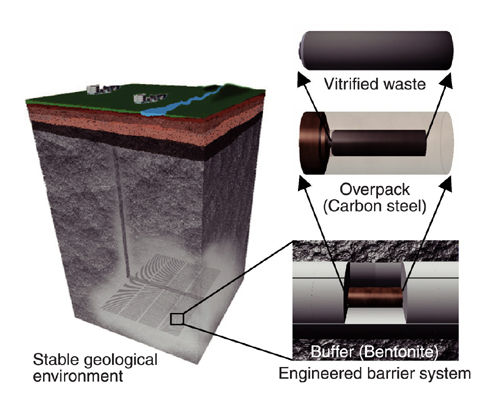
Fig.2-1 Concept of geological disposal
Fig.2-2 JAEA's R&D activities on geological disposal technology
High-level radioactive waste (hereafter, HLW) is generated when we utilize nuclear power. In Japan, reprocessing is done to recover uranium and plutonium remaining in spent fuel from power generating reactors, for recycling into useful fuel. The liquid remaining after such retrieval is finished is vitrified to produce a chemically and physically stable glass, which is HLW. International consensus has been reached that HLW can be disposed of in stable deep geological strata (geological disposal) so as to be isolated from human environments for a long term. Waste glass inserted in an over pack (e.g. carbon steel) with a bentonite buffer around that will be placed at a depth below 300m in the Japanese proposal (Fig.2-1).
For initiating repository operation in the late 2030s, the Nuclear Waste Management Organization of Japan (NUMO), with responsibility for implementing geological disposal of HLW, is now calling for municipalities to volunteer as candidate siting areas and be surveyed, which is the first stage in the final disposal project. The first application came this January from Toyo town, Kochi prefecture, but it was withdrawn after the subsequent mayoral election in April.
To ensure safe implementation of geological disposal, we have conducted R&D in various fields, e.g. geoscientific research, engineering development, and performance assessment (PA) of the geological disposal system.
A particular JAEA R&D activity is to promote the projects of two Underground Research Laboratories (URLs): one at Mizunami city situated in crystalline rock and the other at Horonobe town situated in sedimentary rock (Fig.2-2). The results of the 1st R&D Phase (investigations from the surface) were entered in the 2006 report. Phase 2, excavation of shafts and drifts, is underway. Research on geological phenomena such as fault and volcanic activities also has progressed.
At the same time, we are conducting laboratory experimental studies at the Tokai research center. The relatively large-scale and non-radioactive experiments, performance assessment of the multibarrier system supported by extensive computer analysis, and research to obtain basic data concerning the chemical properties and migration behavior of radionuclides under geological disposal conditions have been carried out. These studies are linked with the geological environment data obtained from the URLs. In 2006, JAEA s diffusion database of radionuclides was released on the Web to serve as an important tool for safety assessment.
Geological disposal of HLW will be a long term project of more than one hundred years. It is supported by huge amounts of extremely diverse information which must be organized to reveal multiple lines of evidence relevant to safety. Management of knowledge is a very important issue for this long-term disposal program. JAEA has conducted a project to develop the next generation novel knowledge management system (KMS). Various evidence and information derived from a wide range of R&D activities will be managed systematically and made transmittable in a knowledge base in the KMS. In March 2007, the base-line design of KMS was completed.
In July 2005, a "Geological Disposal R&D Coordination Council" was established to coordinate wide ranging R&D which is being carried out by JAEA and ANRE (Agency for Natural Resources and Energy). In this council, JAEA and related R&D organizations have discussed their respective roles, created a co-operation framework to integrate R&D results into a database, and prepared a roadmap for the implementation of geological disposal. The roadmap was reported at an open council symposium in March 2007.